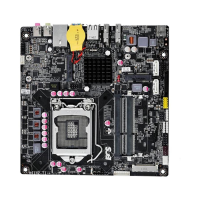
Do you have a question about the ECS H61H2-TI and is the answer not in the manual?
| Form Factor | Micro ATX |
|---|---|
| Socket | LGA 1155 |
| Chipset | Intel H61 |
| Memory Slots | 2 x DIMM |
| Max Memory | 16 GB |
| SATA Ports | 4 |
| USB 2.0 Ports (Rear) | 4 |
| Audio Codec | Realtek ALC662 |
| LAN | Realtek RTL8111E Gigabit LAN |
| Power Connector | 24-Pin ATX, 4-Pin ATX 12V |
| Memory Support | DDR3 1333/1066 MHz |
| Expansion Slots | 1 x PCI Express x16, 1 x PCI Express x1, 1 x PCI |
| Storage Interface | SATA 3Gb/s |
| Audio | Realtek ALC662 |
| Video Outputs | 1 x VGA |
Overview of the motherboard's purpose and a list of included package items.
Details the technical specifications of the motherboard, covering CPU, memory, ports, and more.
Visual guide to motherboard connectors and rear panel I/O ports.
Essential safety precautions and steps for mounting the motherboard into a computer case.
Configuration of jumpers and installation of core hardware like CPU and RAM.
Step-by-step guide for installing the CPU into its socket.
Procedure for mounting the CPU cooler for effective heat dissipation.
Instructions for correctly inserting DDR3 memory modules into the DIMM slots.
Installation of expansion cards and connection of optional devices like USB and audio headers.
Connecting hard drives, optical drives, and internal case components like power and reset switches.
Introduction, standard configuration, and access methods for the BIOS setup utility.
Explains navigation keys and covers Main, Advanced, Chipset, Frequency/Voltage, Boot, Security, and Exit menus.
Configuration options for CPU, SATA, USB, and other system components.
Adjustments for chipsets, CPU overclocking, and system voltages.
Settings for boot order, operating system selection, and system passwords.
Step-by-step guide for downloading and installing new BIOS versions.
Guide to installing drivers and software using the DVD-ROM's auto-run feature.
Alternative method for installing drivers via file manager if auto-install fails.
Solutions for common issues encountered when the PC is first assembled.
Troubleshooting steps for issues arising after the PC has been used for some time.
Advice on proper care and maintenance to ensure motherboard longevity.
